SUBFAMILY DOLICHODERINAE
Genus Tapinoma Förster
| The
Ants of Africa SUBFAMILY DOLICHODERINAE Genus Tapinoma Förster |
|
| Dolichoderinae Introduction |
Type-species: Tapinoma collina (Förster, 1850a: 43; junior synonym of Tapinoma erraticum (Latreille, 1798), synonymy by Schenk, 1852: 67) by monotypy. Tapinoma senior synonym of Micromyrma Mayr (1863: 455); senior synonym of Neochystopsenella: [India] Brown (1988a: 137); senior synonym of Semonius, Tapinoptera and Zatapinoma [Asia], with genus review, Shattuck (1992c: 146).
Diagnostic Features - Eyes at or in front of the midlength of the head on the dorsal surface. Clypeus with or without the anterior margin emarginate. Mandibles with large apical two or three teeth, followed by a row of denticles. Palp formula, 6,4; and palpi long. Propodeum unarmed or rarely with a pair of blunt tubercles. Gaster in dorsal view with four visible tergites, the anal and associated orifices are ventral. Shattuck (1991: 108) noted that of the Dolichoderines only Tapinoma has elongate scapes in the male.
Förster's
(1850a) genus definition is at ![]() .
Mayr's (1861: 41) gave a genus description, this is at
.
Mayr's (1861: 41) gave a genus description, this is at ![]() .
Arnold (1915: 152) gave a note on the genus, with a key to South
African species, this is at
.
Arnold (1915: 152) gave a note on the genus, with a key to South
African species, this is at ![]() .
.
Forel (1910f: 21) defined Semonius
as a new Dolichoderine genus, the definition is at ![]() .
Arnold (1915: 157) gave a note on the genus, this is at
.
Arnold (1915: 157) gave a note on the genus, this is at ![]() .
.
Bolton (1995) lists a few species from Zaďre, eastern and southern Africa but has no species of which the holotypes came from West Africa. Wheeler (1922) noted how Tapinoma melanocephalum had become distributed by commerce throughout the tropics, and that the workers of the genus are timid and emit from their anal glands a strong odour like "rancid butter" ("Tapinoma-odor").
Provisional
key to African species
Based mainly on
original descriptions and almost certainly meriting further revision.
| 1 | 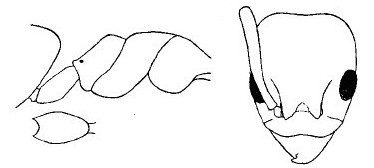 Head heart-shaped,
relatively large TL 2.0-3.0 mm; anterior margin of clypeus with
low-curved median notch, overall dull yellow with gaster blackish-brown
to dark-brown Head heart-shaped,
relatively large TL 2.0-3.0 mm; anterior margin of clypeus with
low-curved median notch, overall dull yellow with gaster blackish-brown
to dark-brown |
. |
| . | 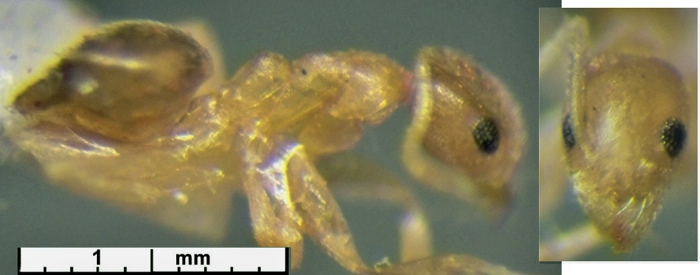 |
Congo Basin east to Kenya - luridum |
| -- | Head with occiput not impressed; anterior margin of clypeus straight or weakly sinuous | 2 |
| 2 |  Head
with a smoothly ovoid outline; eyes set
about the mid-point of the head or only slightly forward of the
mid-point Head
with a smoothly ovoid outline; eyes set
about the mid-point of the head or only slightly forward of the
mid-point |
3 |
| -- |  Head
elongated with a
relatively straight occiput; eyes set within anterior third of the head Head
elongated with a
relatively straight occiput; eyes set within anterior third of the head |
6 |
| . | Head with a smoothly ovoid outline; eyes set about the mid-point of the head or only slightly forward of the mid-point | . |
| 3 | 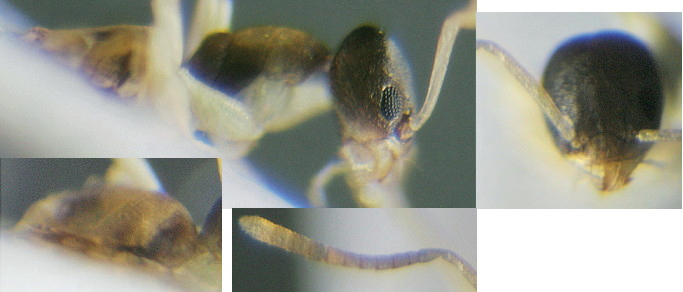 TL
no more than 2.0 mm; HW =
HL; propodeal
declivity weakly convex; head and alitrunk dark yellow brown to near
black, gaster much lighter to yellow, extremities paler TL
no more than 2.0 mm; HW =
HL; propodeal
declivity weakly convex; head and alitrunk dark yellow brown to near
black, gaster much lighter to yellow, extremities paler |
Panafrican & global tramp species - melanocephalum |
| -- | HL > HW | 4 |
| 4 |  TL
at least 2.5 mm; head and body unicolourous dark brown;
anterior margin of clypeus weakly and smoothly convex TL
at least 2.5 mm; head and body unicolourous dark brown;
anterior margin of clypeus weakly and smoothly convex |
Zaďre
& Guinea - longiceps |
| -- | Base colour light brown to yellow | 4 |
| 5 |  TL
2.3 mm; colour
brown, alitrunk and pedicel lighter, appendages dull (dirty) yellow TL
2.3 mm; colour
brown, alitrunk and pedicel lighter, appendages dull (dirty) yellow |
. |
| . |  |
Somalia - chiaromontei |
| -- | 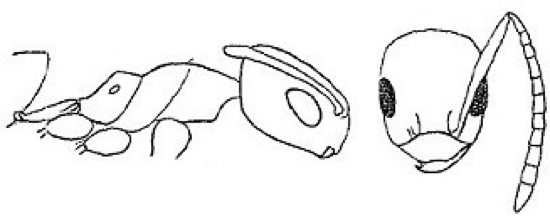 TL
2.2 mm; uniform dull yellow, head and gaster
brownish, silky; pubescence dense but very short; anterior margin of
clypeus weakly convex but feebly scalloped; eyes set around the
mid-point, angled ovoid; scape surpassing occiput by one-quarter its
own length TL
2.2 mm; uniform dull yellow, head and gaster
brownish, silky; pubescence dense but very short; anterior margin of
clypeus weakly convex but feebly scalloped; eyes set around the
mid-point, angled ovoid; scape surpassing occiput by one-quarter its
own length |
. |
| . | 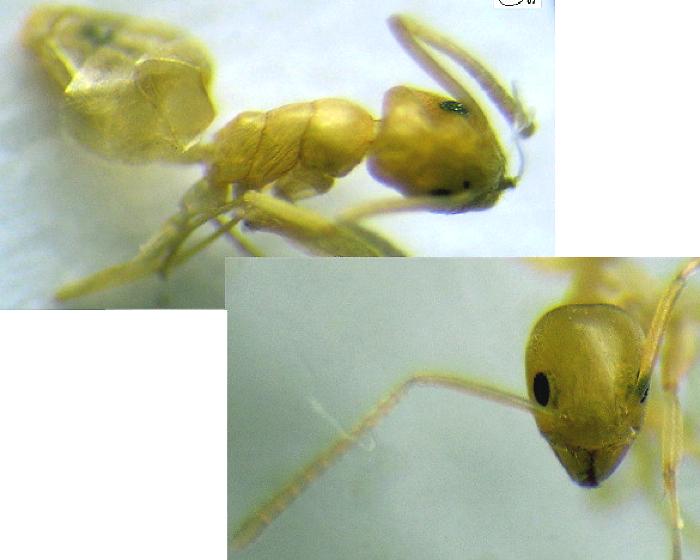 |
Kenya - connexum |
| . | Head elongated (HL > HW) with a relatively straight occiput | . |
| 6 | Propodeum in profile with a distinct sharp transition from dorsum to declivity | 7 |
| -- | Propodeum in profile with the transition from dorsum to declivity no more than a rounded angle | 10 |
| 7 |  Propodeum with
declivity in profile flat. TL 1.4 mm; antennal scape
not reaching the occiput; pubescence very short and scanty; yellow
brown, smooth and shiny Propodeum with
declivity in profile flat. TL 1.4 mm; antennal scape
not reaching the occiput; pubescence very short and scanty; yellow
brown, smooth and shiny |
Tanzania - mcgavini new species |
| -- | Propodeum in profile with the transition from dorsum to declivity sharply defined, the declivity concave and the angle with a raised apex | 8 |
| 8 | 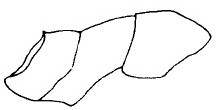 TL ca 2.0 mm, HL 0.53, HW 0.42, CI 75, SL 0.5, SI 138, PW
0.30, eye
length 0.15; funiculus segments mostly about as wide as they
are long; finely &
shallowly reticulate; pilosity a whitish appressed pubescence; colour
grayish brown, appendages paler TL ca 2.0 mm, HL 0.53, HW 0.42, CI 75, SL 0.5, SI 138, PW
0.30, eye
length 0.15; funiculus segments mostly about as wide as they
are long; finely &
shallowly reticulate; pilosity a whitish appressed pubescence; colour
grayish brown, appendages paler |
. |
| -- | 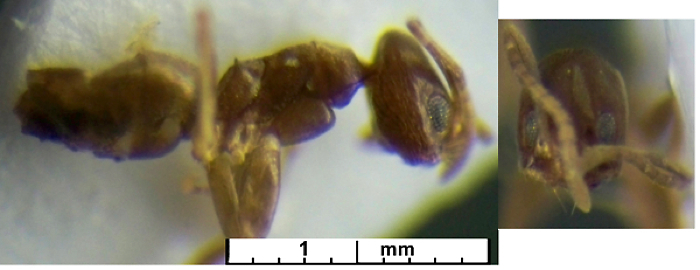 |
West Africa to Sudan - carininotum |
| -- | Colour dull brown-black - two apparently
identical forms; if so Tapinoma
acuminatum is the senior synonym |
9 |
| 9 |  Propodeum with declivity
distinctly bordered
and concave; funiculus segments all longer than wideTL 1.6-1.9 mm;
colour dull blackish yellow Propodeum with declivity
distinctly bordered
and concave; funiculus segments all longer than wideTL 1.6-1.9 mm;
colour dull blackish yellow |
. |
| . |  TL ca 1.5 mm, HL 0.48, HW 0.40,
CI 85, SL 0.42 , SI 113, PW 0.27, eye length 0.12 TL ca 1.5 mm, HL 0.48, HW 0.40,
CI 85, SL 0.42 , SI 113, PW 0.27, eye length 0.12 |
Zimbabwe & Congo Basin - lugubre |
| -- |  TL 1.5 mm; head
a rounded rectangle, HL > HW; eyes "large"; antennal scape
surpassing occiput by about one-fifth of its own length; shiny,
pubescent; brown, alitrunk lighter, appendages smoky brown-yellow TL 1.5 mm; head
a rounded rectangle, HL > HW; eyes "large"; antennal scape
surpassing occiput by about one-fifth of its own length; shiny,
pubescent; brown, alitrunk lighter, appendages smoky brown-yellow |
Kenya (Fundu I.) - acuminatum |
| . | Propodeum in profile with the transition from dorsum to declivity no more than a rounded angle | . |
| 10 | Antennal scape clearly surpassing the occipital border | 11 |
| -- | Antennal scape not surpassing the occipital border | 12 |
| 11 | 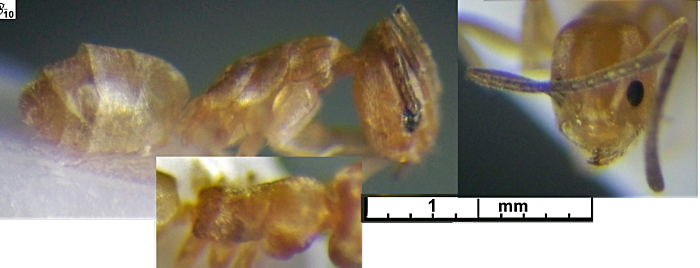 Antennal scape
surpassing
occipital border by about 1/4 of its own length; TL 2 mm (variety emeryi
TL 2.7-3.0 mm); colour pale flavous yellow; whole body very finely
spiculate giving it a matt appearance Antennal scape
surpassing
occipital border by about 1/4 of its own length; TL 2 mm (variety emeryi
TL 2.7-3.0 mm); colour pale flavous yellow; whole body very finely
spiculate giving it a matt appearance |
Pan-African (savannah?) - luteum |
| -- | 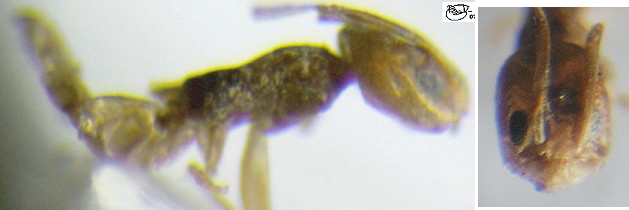 Antennal scape surpassing the occiput by
1/3 its own length; TL 2 mm; eyes large set slightly forward of the
mid-point of the head; legs very long; subopaque and densely punctate;
colour ochreous; apex of gaster and funiculi brownish Antennal scape surpassing the occiput by
1/3 its own length; TL 2 mm; eyes large set slightly forward of the
mid-point of the head; legs very long; subopaque and densely punctate;
colour ochreous; apex of gaster and funiculi brownish |
Zimbabwe - demissum |
| . | Antennal scape not surpassing the occipital border | . |
| 12 | 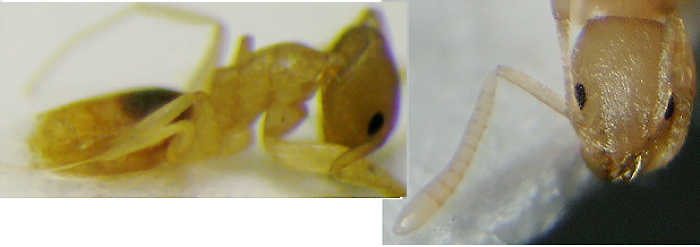 Antennal
scape reaching the occipital border;
TL 1.4-1.5 mm; colour yellow ochre; anterior margin of clypeus feebly
notched; mandibles quite large with small denticles and three distinct
apical teeth Antennal
scape reaching the occipital border;
TL 1.4-1.5 mm; colour yellow ochre; anterior margin of clypeus feebly
notched; mandibles quite large with small denticles and three distinct
apical teeth |
Zimbabwe west to Benin and Mali - modestum |
| -- | Antennal scape reaching about 3/4 point of head; black or brownish | 13 |
| 13 | 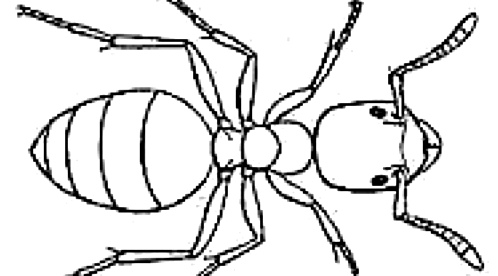 TL
1.8-3.0 mm; base colour near black but with
dense, greyish, microscopic pubescence all over TL
1.8-3.0 mm; base colour near black but with
dense, greyish, microscopic pubescence all over |
. |
| . |  |
Botswana & Tanzania - schultzei |
| -- | TL maximum 1.8 mm | 14 |
| 14 |  TL 1.8
mm; mandibles with 4 distinct teeth, the
apical tooth strongest, also 10-12 denticles; propodeal dorsum and
declivity flat, sub-bordered; yellow sometimes with the gaster brownish TL 1.8
mm; mandibles with 4 distinct teeth, the
apical tooth strongest, also 10-12 denticles; propodeal dorsum and
declivity flat, sub-bordered; yellow sometimes with the gaster brownish |
Madagascar - subtile |
| -- | TL > 1.8 mm | 15 |
| 15 | 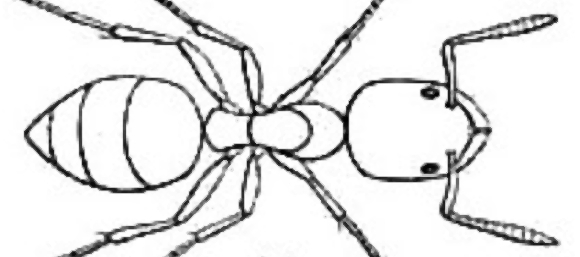 TL
1.6-1.7 mm; colour light brown; mandibles
narrow with only a few minute teeth; eyes quite small TL
1.6-1.7 mm; colour light brown; mandibles
narrow with only a few minute teeth; eyes quite small |
. |
| . |  |
Southern Africa form - arnoldi |
| -- | TL maximum 1.8 mm; mandibles quite large | 16 |
| 16 | Base colour yellowish-brown | 17 |
| -- | Base colour dark brown to near black | 19 |
| 17 |  TL
ca 1.8 mm; paler
yellow with longer scapes, SI 100; eyes set in slight depressions on
the sides of the head; occiptum evenly rounded in full face view;
propodeum with rounded transition
from dorsum to declivity TL
ca 1.8 mm; paler
yellow with longer scapes, SI 100; eyes set in slight depressions on
the sides of the head; occiptum evenly rounded in full face view;
propodeum with rounded transition
from dorsum to declivity |
Nigeria & Cameroun - Tapinoma Nigeria sp T1 new species |
| -- | TL maximum 1.5 mm | 18 |
| 18 | 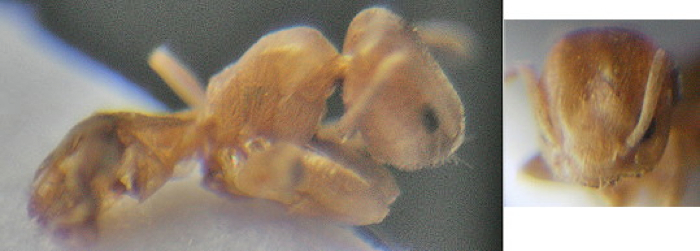 TL 1.2-1.4 mm; colour
pale
ochreous or pale reddish ochreous to pale yellowish sepia-brown;
anterior margin of clypeus straight; eyes set no further back from the
anterior margin of the head than about their own length TL 1.2-1.4 mm; colour
pale
ochreous or pale reddish ochreous to pale yellowish sepia-brown;
anterior margin of clypeus straight; eyes set no further back from the
anterior margin of the head than about their own length |
Southern Africa - minimum |
| -- |  TL ca 1.5 mm; similar
but
with larger eyes and thicker scapes; the latter with quite dense
pubescence TL ca 1.5 mm; similar
but
with larger eyes and thicker scapes; the latter with quite dense
pubescence |
Tanzania - mkomaziae new species (Tanzania 3/68/07) |
| 19 |  TL 1.2-1.7 mm;
pubescence
very short and scanty; dark brown, smooth and shiny TL 1.2-1.7 mm;
pubescence
very short and scanty; dark brown, smooth and shiny |
South Africa & Tanzania - danitschi |
| -- | 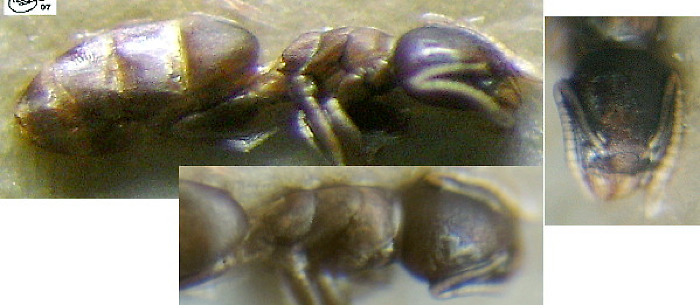 TL 1.45-1.59 mm, HL 0.47,
HW 0.40, CI = 112, SL 0.31, SI = 77, PW 0.26 TL 1.45-1.59 mm, HL 0.47,
HW 0.40, CI = 112, SL 0.31, SI = 77, PW 0.26Eyes set well forward of the midline of the sides of the head; scapes very short (under two-thirds of HL); funiculus apical segment swollen, segments 9-10 slightly larger than 2-8; in dorsal view alitrunk with near right angled anterior lateral shoulders; promesonotal suture arched forward; propodeum with rounded raised transition from dorsum to declivity, declivity flat; erect setae only on the clypeus; head, alitrunk and gaster dull due to dense imbrication; dense fine flat pubescence; dark brown, except antenna, tarsi and tibiae which are colourless. |
West Africa - debouti new species |
| 19 | 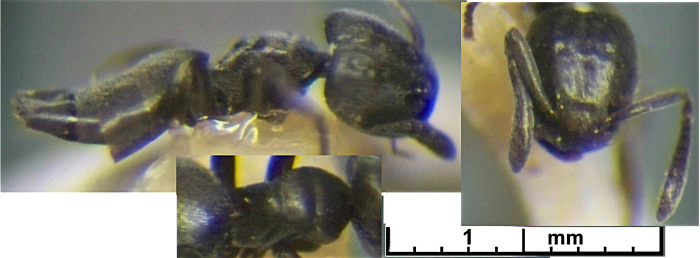 TL 1.59 mm, HL 0.47, HW 0.40, SL 0.31,
PW 0.26 TL 1.59 mm, HL 0.47, HW 0.40, SL 0.31,
PW 0.26Colour all over brown, shiny. Antennal scapes noticeably short relative to the head length. Erect hairs only on the clypeus. Dense fine pubescence on all surfaces except the sides of the head, where it is sparse. Dorsum of alitrunk nearly smoothly convex in profile with a slight depression at the metanotal suture. |
Nigeria & Cameroun - n sp. CRIN T2 |
|
©
2007,
2008, 2009, 2010, 2011, 2013, 2014 - Brian Taylor CBiol FSB FRES 11, Grazingfield, Wilford, Nottingham, NG11 7FN, U.K. |
href="tapinoma.htm"